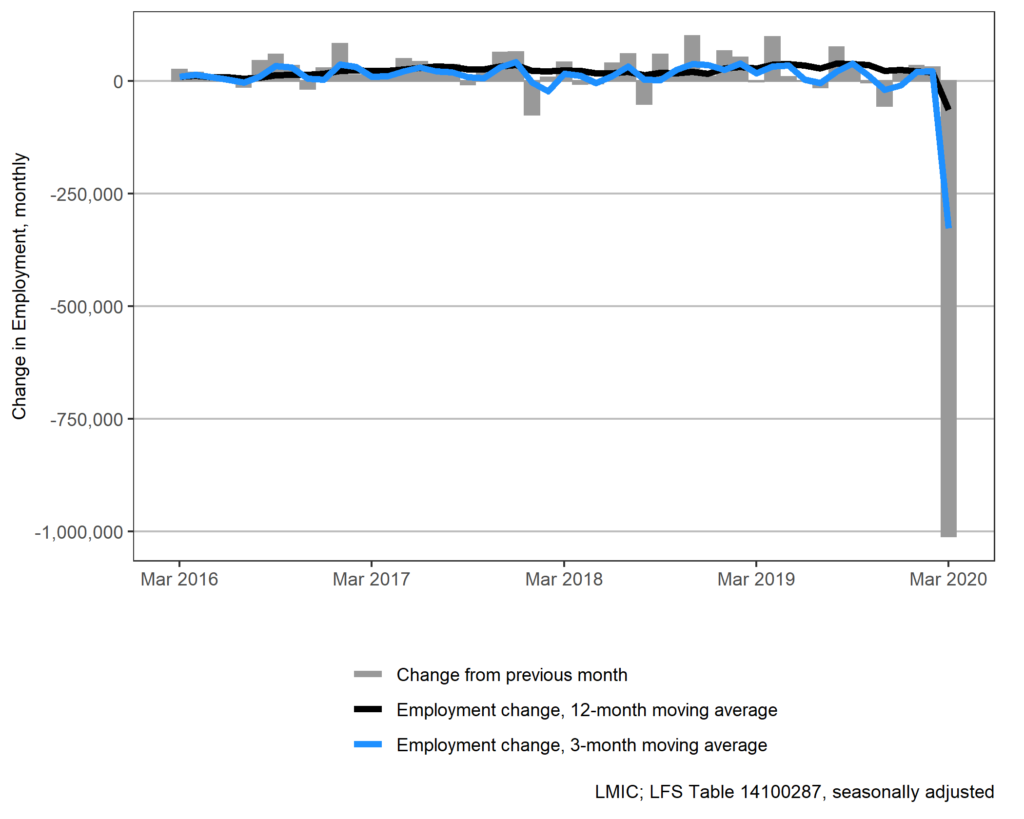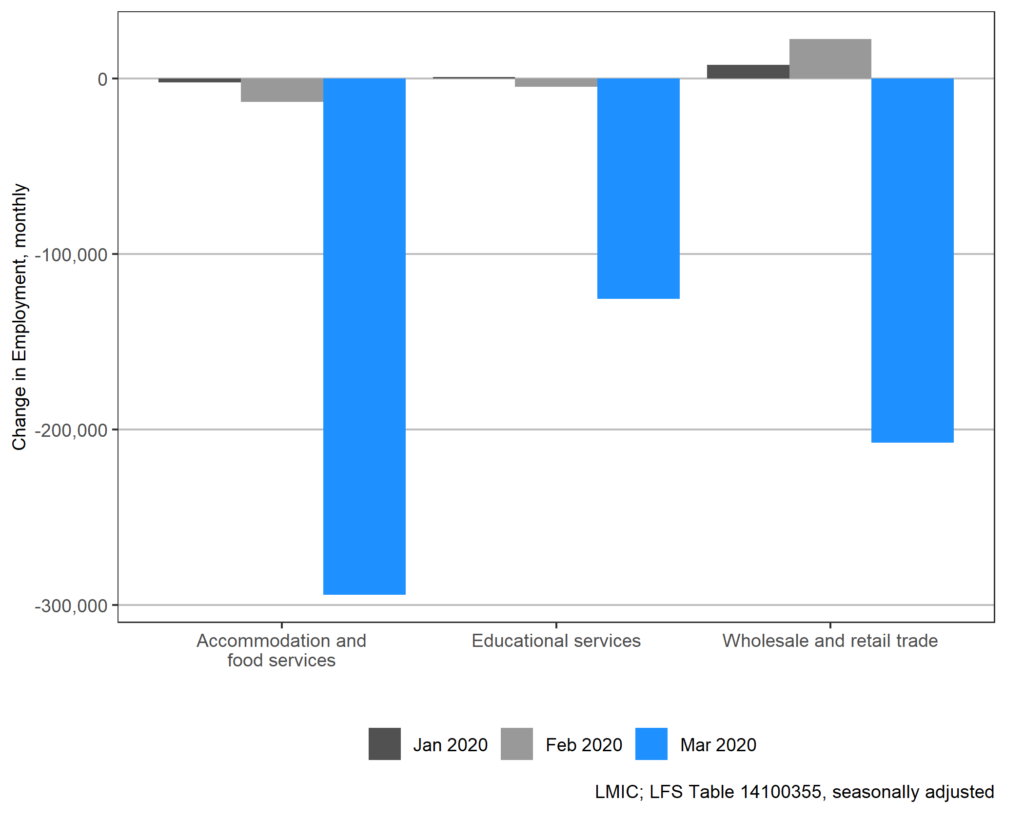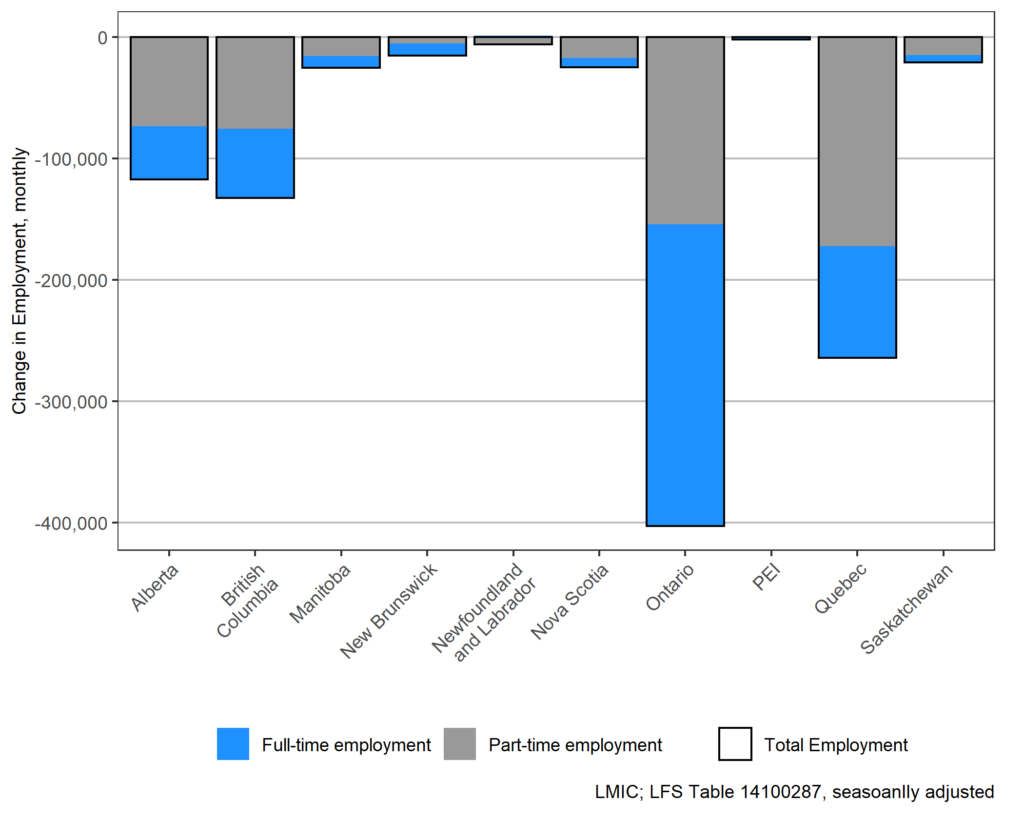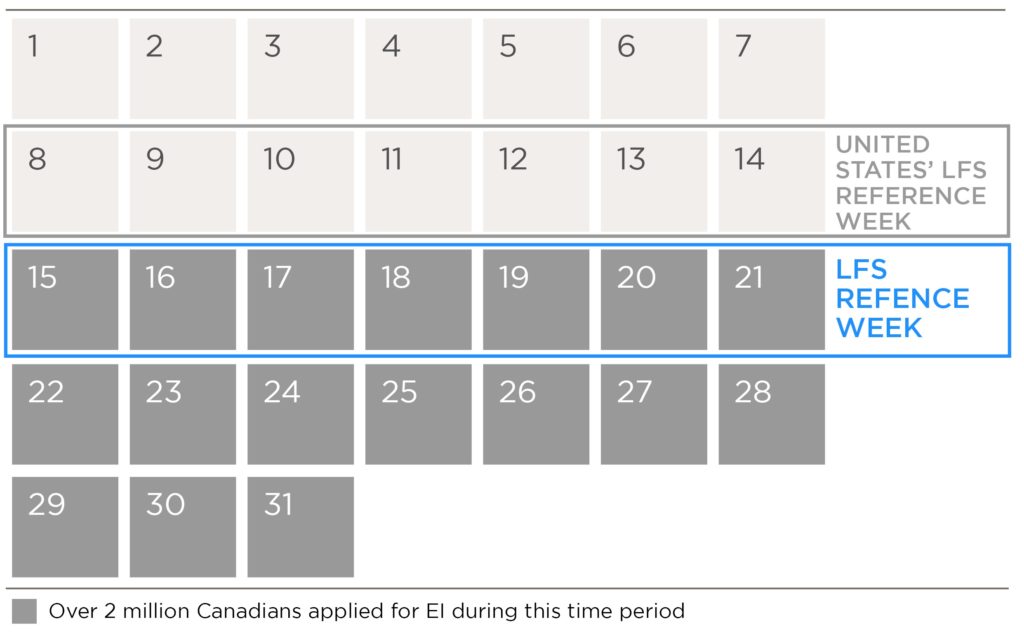
Early Signs of the COVID-19 Impact on Canada’s Job Market
Employment fell by 1,010,700 in March in Canada – the largest drop on record –and the unemployment rate jumped to 7.8% from 5.6% in February. So say the first official statistics covering the onset of the COVID-19 crisis (see Figure 1), released today as part of the Labour Force Survey (LFS). Although these early indicators show how various labour market segments are being impacted, there is still much we don’t yet know. As more data are collected and compiled over the coming weeks and months, a more complete picture of the depth of this unprecedented economic retrenchment will emerge. With that in mind, here are some of the major trends observed in today’s LFS release, along with some guidance as to when more data will become available.
Figure 1: Monthly Employment Change, Canada
March 2020

Headline figures
Job losses were spread across many sectors with the biggest total falls occurring in Wholesale and retail trade (41, 44–45), Accommodation and food services (72) and Educational services (61) (see Figure 2). Almost 300,000 jobs were lost in the Wholesale and retail trade, accounting for nearly one third of all job losses. Regionally, the most severe contractions in total employment level occurred in British Columbia, Quebec and Ontario, which were among the first provinces to implement social distancing and other measures designed to prevent the spread of COVID-19 (see Figure 3). On a year-to-year basis, British Columbia, Newfoundland and Labrador and Alberta experienced the steepest employment declines in relative terms (falling by 5.9%, 5.4% and 5.1%, respectively). In addition to facing the pandemic, Alberta and Newfoundland and Labrador have suffered from the crash in oil prices caused by the glut in supply from Saudi Arabia and Russia.
Figure 2: Monthly Change in Employment Level, Selected Industries
Change in employment, past 3 months to March 2020

Figure 3: Monthly Employment Change by Province and Full-Time/Part-Time Status
March 2020

Figure 4 shows the monthly change in employment by broad occupational group. Sales and service occupations (6) bore the brunt of the economic shutdown with employment in these occupations falling by 606,100 from last month – a 13.3% decline – accounting for two-thirds of all job losses. In relative terms, employment in Occupations in art, culture, recreation and sport (5) fell the most, down by 16.8% (or, 90,800) from last month. Job losses were, in the context of this crisis, less severe in Health-related occupations (2), falling by 49,300 from February (but increasing from March 2019 by 9,700).
Figure 4: Monthly Growth in Employment Level, Selected Occupations
Growth in employment, past 3 months to March 2020

Overall, the employment numbers point to a severe impact on the lives of millions of Canadians. Yet, as explained below, these figures underestimate the depth of the labour market impact experienced in March 2020.
More job losses to come: Last week of March not yet captured in official statistics
The LFS asks respondents about their employment market status during the previous week. The survey was conducted between March 23 and 31, using March 15–21 as the reference week (see Figure 5). This means that today’s LFS release focuses on one of the most consequential weeks of the post-war era. By the end of the reference week, nearly every jurisdiction had declared emergency measures to protect the public, including restricting the operation or outright closure of thousands of non-essential business across the country. Importantly, the LFS classifies respondents as “Employed” if they worked at least one hour during the reference week, meaning that anyone who lost their job during the week is nevertheless counted as employed.
Even though Canada’s LFS focused on this critical week, there is reason to expect that job losses continued at an unprecedented pace during the final week of March. However, the Canadian LFS figures should more accurately reflect the employment impacts from COVID-19 than those of the United States. The US LFS (released on Friday, April 3) used the reference week of March 8–14, which was before most measures came into effect.
Figure 5: COVID-19 Events of March 2020

Government announcements since the onset of the pandemic have provided early indications of the magnitude of March job losses, with over two million applications for Employment Insurance (EI) made in the second half of March. Since only half a million of those claims were initiated before March 20, at least 1 million took place after the LFS reference week.
Typically, fewer than half of unemployed persons are eligible for EI, suggesting that the job losses last month are higher than EI figures indicate. Expanding access to EI and related benefits is a key function of support offered via the new Canada Emergency Response Benefit (CERB). As of April 8, Canadians could start applying for the CERB and upwards of 2.2 million did so in the first three days since the program launched. All of which suggests job losses continued, if not accelerated, during last week of March, which will be captured in the next official LFS release on May 8.
Where we go from here
Today we received the first bit of insight into the labour market impact of the COVID-19 pandemic. Though the data do not yet reflect the full employment effects, clearly millions of Canadians have lost and are losing their jobs and income. The decisions that Canadians now make about jobs, careers, education, training and workforce development just got a lot tougher, especially for those aged 15–24, among whom employment is down by 13.5% (this is heavily skewed toward the younger half of the group).
For those of us tracking the economic and labour market impacts of COVID-19, the next LFS will be released on May 8, providing job numbers for the month of April. Official EI and payroll statistics for March are slated for release on May 21 and 28, respectively; however, the regular release of EI statistics might be delayed as Statistics Canada focuses on mission-critical activities. Estimates of GDP for 2020 Q1 will be released on May 29. These data will give us a better sense of the magnitude of job losses resulting from the crisis.
Since the beginning of this pandemic, we at LMIC have shifted our activities to best respond. We are diligently monitoring labour market and broader economic developments as data become available, working remotely to protect each other and all Canadians. We are committed to supporting Canadian resilience and the strength of our economy, now and into the future. This mandate is more important — and more challenging — than ever before.
In the meantime, we encourage everyone to follow recommendations from their local health authority and to support each other during these trying times. Stay safe, stay healthy, and stay (remotely) connected.

Tony Bonen is LMIC’s Director, Research, Data and Analytics. He leads LMIC’s team of economists, investigating everything from Canada’s diverse labour market information needs to the potential implications of the changing nature of the world of work.